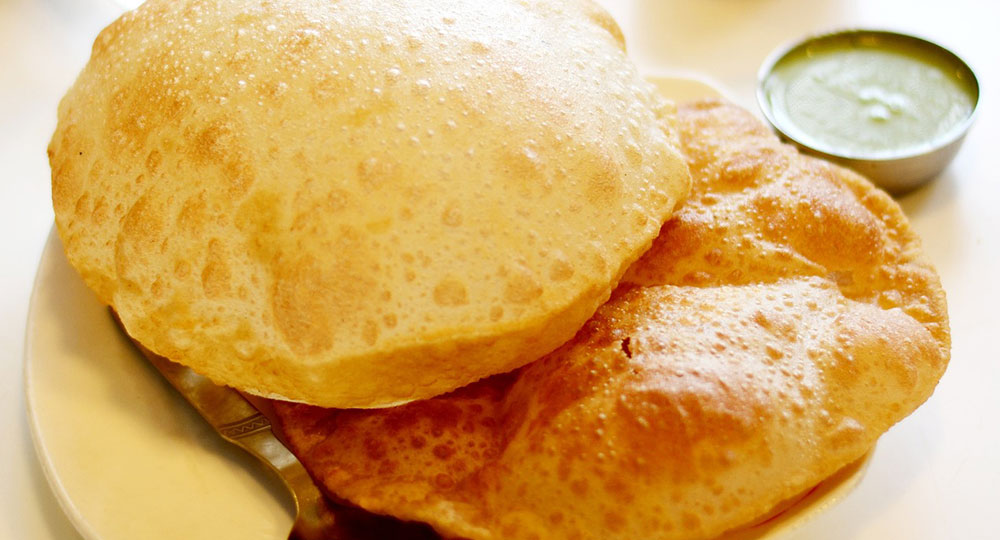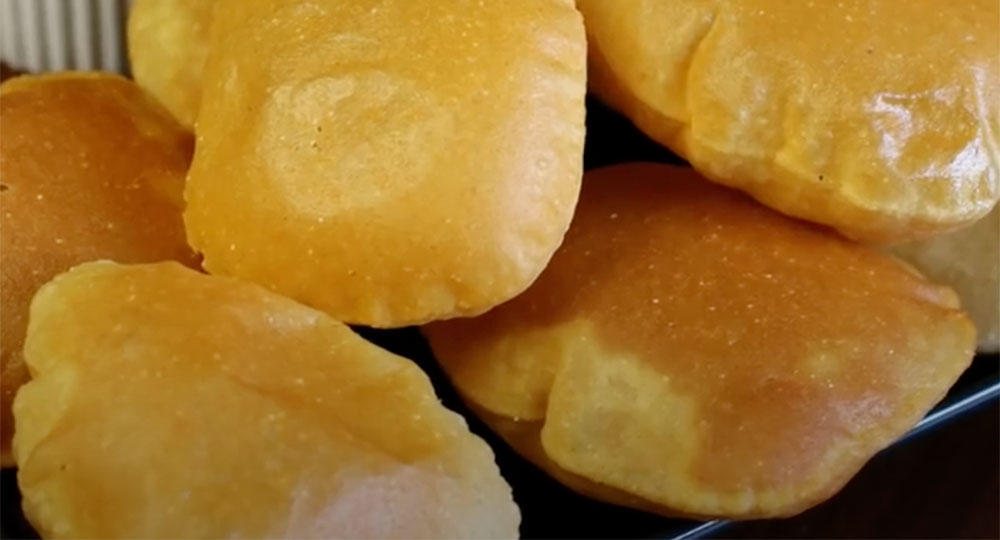
Vegetable Tempura (Kakiage)
August 5, 2024
The Versatility of Tofu in Vegetarian Recipes
August 8, 2024
Vegetable Tempura (Kakiage)
August 5, 2024
The Versatility of Tofu in Vegetarian Recipes
August 8, 2024
Indian Puffy Puri
Indian cuisine is a tapestry of diverse flavors, vibrant colors, and rich traditions. Among its many treasures, the humble puri stands out as a beloved staple, especially in vegetarian recipes. This unleavened bread, made from whole wheat flour, is celebrated not only for its simplicity but also for its versatility in complementing a wide array of vegetarian dishes.
20 mins
Easy
Serves 4
Origins and Cultural Significance
Puri, also spelled as poori, has ancient roots in Indian culinary tradition. It is believed to have originated in the Indian subcontinent and has been a part of the Indian diet for centuries. Puri is deeply embedded in Indian culture, often prepared during festivals, religious ceremonies, and special occasions. Its ease of preparation and adaptability to various vegetarian dishes make it a favorite across Indian households.
Ingredients and Preparation
The primary ingredients for puri are whole wheat flour, water, and a pinch of salt. Some recipes also incorporate a bit of oil or ghee to enhance the dough's texture. The preparation begins with kneading the dough until it reaches a smooth consistency. The dough is then divided into small balls, which are rolled out into flat circles, typically around 4-5 inches in diameter. These circles are deep-fried in hot oil until they puff up and turn golden brown. The puffing is due to the water in the dough turning into steam, creating an airy pocket inside the puri.

Nutritional Value
Puri, made from whole wheat flour, is a good source of carbohydrates and provides energy. It also contains dietary fiber, which aids in digestion. When cooked in moderate amounts of oil, puris can be a part of a balanced vegetarian diet. Pairing puris with nutrient-rich vegetarian dishes ensures a wholesome and satisfying meal.
Here is a breakdown of the nutritional aspects of puri.
-
Carbohydrates:
- Whole Wheat Flour: The primary ingredient in puri is a good source of carbohydrates, providing the energy needed for daily activities.
- Fiber: Whole wheat flour also contains dietary fiber, which aids in digestion and helps maintain a healthy digestive system.
-
Proteins:
- Puri contains a moderate amount of protein from the whole wheat flour, which is essential for body repair and growth.
-
Fats:
- Oil: Puri is deep-fried, which adds fat content. The type of oil used for frying (such as vegetable oil, sunflower oil, or ghee) influences the fat content and nutritional quality.
- Saturated and Unsaturated Fats: The fat profile includes both saturated and unsaturated fats, with the proportion varying based on the frying oil.
-
Vitamins and Minerals:
- Iron: Whole wheat flour is a source of iron, which is vital for the production of hemoglobin in the blood.
- B Vitamins: These vitamins, including B1 (thiamine), B3 (niacin), and B9 (folate), are found in whole wheat flour and play crucial roles in energy metabolism and overall health.
- Magnesium and Zinc: Whole wheat flour also provides minerals like magnesium and zinc, important for various bodily functions.
-
Calories:
- The caloric content of puri can be significant due to the frying process. On average, a single puri can contain around 100-150 calories, depending on its size and the amount of oil absorbed during frying.
Detailed Nutritional Information (Approximate values per puri, 25-30 grams):
- Calories: 100-150 kcal
- Carbohydrates: 15-20 grams
- Protein: 2-3 grams
- Fat: 4-7 grams
- Saturated Fat: 1-2 grams
- Unsaturated Fat: 3-5 grams
- Fiber: 1-2 grams
- Iron: 0.7-1 mg (around 5-10% of daily value)
- Sodium: 50-100 mg (varies with added salt)
Health Considerations
- Moderation: Due to its deep-fried nature, puri should be consumed in moderation, especially for individuals concerned about calorie intake, fat consumption, or maintaining a healthy weight.
- Oil Quality: Using high-quality oil with a high smoke point for frying can improve the nutritional quality. Oils like sunflower oil, canola oil, or even traditional ghee can be used.
- Whole Wheat Benefits: Opting for whole wheat flour over refined flour (maida) can enhance the nutritional value by providing more fiber, vitamins, and minerals.
Versatility in Vegetarian Cuisine
Puri's neutral flavor and soft, airy texture make it an excellent accompaniment to a variety of vegetarian recipes. Here are some classic vegetarian dishes that are often paired with puri:
-
Aloo Bhaji: A spiced potato curry, aloo bhaji is one of the most popular companions to puri. The softness of the puri perfectly complements the rich, savory flavors of the potatoes.
-
Chole: This hearty chickpea curry, cooked with tomatoes, onions, and a blend of spices, pairs wonderfully with puri. The combination is not only filling but also highly nutritious, providing a good balance of protein and carbohydrates.
-
Halwa: A traditional Indian sweet made from semolina, sugar, and ghee, halwa is often served with puri during special occasions and festivals. The sweet and savory combination creates a delightful contrast of flavors.
-
Saag Paneer: A creamy spinach and paneer (Indian cottage cheese) dish, saag paneer is another excellent pairing with puri. The richness of the paneer and the earthy flavor of the spinach enhance the overall meal experience.
-
Mixed Vegetable Curry: Puri can also be enjoyed with a medley of vegetables cooked in a spicy gravy. This dish is a great way to incorporate a variety of vegetables into the diet, making the meal both nutritious and flavorful.
Cultural Variations
Conclusion
Puri holds a cherished place in the Indian culinary landscape, especially within the realm of vegetarian recipes. Its simple preparation, nutritional value, and ability to complement a wide variety of vegetarian dishes make it an indispensable part of Indian meals. Whether enjoyed during festive celebrations or as part of a regular meal, puri continues to be a symbol of the rich and diverse culinary heritage of India.
Simple and traditional recipe for making Indian puri.
Here's a simple and traditional recipe for making Indian puri.
Ingredients:
- Whole wheat flour (atta): 2 cups
- Salt: 1/2 teaspoon (optional)
- Oil or ghee: 1 tablespoon (for the dough)
- Water: 3/4 cup (approximate, adjust as needed)
- Oil: for deep frying
Instructions:
-
Prepare the Dough:
- In a large mixing bowl, combine the whole wheat flour and salt.
- Add the oil or ghee to the flour mixture. This step helps in making the puris soft and flaky.
- Gradually add water to the mixture while kneading to form a stiff and smooth dough. The dough should be firmer than chapati or roti dough but smooth enough to roll out.
- Cover the dough with a damp cloth and let it rest for about 15-20 minutes.
-
Divide the Dough:
- After resting, divide the dough into small, equal-sized balls. Each ball should be about the size of a lemon or golf ball.
-
Roll the Dough:
- Take one dough ball at a time and roll it between your palms to smooth it out.
- Lightly grease the rolling surface and rolling pin with a few drops of oil.
- Roll each ball into a small, flat circle, about 4-5 inches in diameter. The puri should be of even thickness, not too thin or too thick.
-
Heat the Oil:
- In a deep frying pan or kadhai, heat oil over medium-high heat. To check if the oil is ready, drop a small piece of dough into the oil; if it rises to the surface quickly and puffs up, the oil is ready.
-
Fry the Puris:
- Carefully slide one rolled puri into the hot oil. It should puff up almost immediately.
- Gently press the puri with a slotted spoon to help it puff up completely.
- Fry until the puri is golden brown on both sides, flipping once. This should take about 30-60 seconds per puri.
- Remove the fried puri with a slotted spoon and drain on paper towels to remove excess oil.
-
Serve:
- Serve the puris hot with your choice of side dishes like aloo bhaji, chole, or any other curry. They can also be enjoyed with sweet dishes like halwa.
Tips for Perfect Puris:
- Dough Consistency: Ensure the dough is stiff but pliable. If it's too soft, the puris will absorb more oil and become greasy.
- Rolling Technique: Roll the puris evenly to ensure they puff up properly during frying. Uneven rolling can cause them to remain flat.
- Oil Temperature: Maintain the oil at a consistent medium-high temperature. If the oil is too hot, the puris will brown quickly without cooking properly. If it's too cold, they will absorb more oil and become soggy.
- Quick Frying: Fry the puris quickly to retain their puffiness and crisp texture.
Enjoy your homemade puris with a variety of delicious accompaniments!

